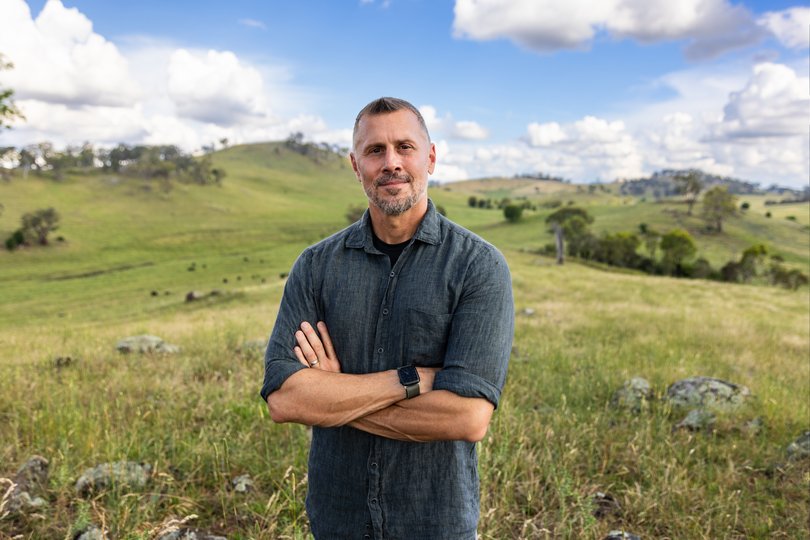Fungi to the rescue in Aussie livestock methane reduction

In a non-descript warehouse on the outskirts of Brisbane, millions of fungi are brewing up a potential solution for an existential problem facing the red meat industry.
In the percolating vats of Roam Agricultural the Curvularia soil fungi, native to Australia, is being a fed a culture to help it rapidly grow. This particular strain of fungi has properties to convert AABB into bromoform - a key ingredient in reducing methane emissions from the gut of ruminant animals.
The agricultural sector accounts for as much as 18 per cent of Australia’s carbon footprint, with methane emissions from sheep and cattle account for approximately 75 per cent of that.
Sign up to The Nightly's newsletters.
Get the first look at the digital newspaper, curated daily stories and breaking headlines delivered to your inbox.
By continuing you agree to our Terms and Privacy Policy.Concerned about the threat to exports, the industry implemented a target of carbon neutrality by 2030, and looks to offset methane emissions, through a combination of genetics, land use change and feed additives.
Individually, some farmers are making enormous investments. In 2023, for instance, one of Australia’s top cattle breeders paid $360,000 for a single Angus bull in pursuit of a bloodline that can produce the highest possible weight gain for the lowest emissions.
Many are engaged in wide scale changes to the way they graze animals, replanting forests and regenerating pastures with more rotational grazing.
But those practices don’t solve the source of emissions - methane.
Which is where science comes in.
CSIRO scientists discovered asparagopsis, a red seaweed native to the north of Tasmania, contains an enzyme that converts the natural bromide found in seawater to create bromoform, which when consumed in a ruminant’s stomach, inhibits the production of methane as a byproduct of converting food to energy.
Unfortunately, cows and sheep don’t really like seaweed, and tens of millions of dollars has been invested in start-ups attempting to find ways to get them to consume it.
Extracting the bromoform, then turning it into a palatable product has been the next problem. Turning the seaweed into food at scale is one issue, doing it at a way that is cost effective another.
On a well-run property, a cow should be adding 1kg of size a day, and early trials saw each dose cost $1 per day. Multiply that by 200 days or so and, boom, there goes your margin.
Roam believes it can solve the manufacturing at scale issue with its brew tanks of microbial fungi at a fraction of the cost of asparagopsis.
“We’ve got this the production of this enzyme off the scale, producing bromoform off a very small footprint,” said Matt Callaghan, Roam’s chief operating officer.
“If you’re growing asparagopsis, you need a lot of hectares of marine leases to grow seaweed, or you take it on land and grow it in tanks. The capital investment in those systems are massive compared just compared to what we’re doing.”
Roam is looking to raise $10 million to perfect the technology and validate the efficacy of the product. Early trials suggest it could reduce methane production by as much as 90 per cent per cent reduction in methane. It says current competitors are showing only 30 per cent abatement, with some also struggling with side effects in terms of lower weight gain.
But the company has launched its capital raise just before a Trump-led backlash against so-called woke causes such as carbon reduction.

Derek Peterson, Roam’s chief executive, who moved from America to run the company, said Mr Trump’s opposition to ESG has “taken US investors right out of the market”.
That has coincided with a dearth of venture capital across the sector.
Sarah Nolet, co-founder and partner at Tenacious Ventures, an ag tech fund which is not an investor in Roam, said the capital raising market had been difficult since the sharp rise in global interest rates in 2022. And getting money into any investment that was not artificial-intelligence related was increasingly a challenge.
But she said there were still plenty of investors who could see the value of satisfying their ESG mandates with commercial outcomes. Agriculture was one sector that satisfied that.
“There’s definitely a pullback, but it’s not yet clear whether that’s sort of a reactive response and how deep it will go, because there do continue to be plenty of cases, especially in food and agriculture, where the commercial benefit and the impact align,” she said.
The shift away from climate-related start-ups will not last as the long term trend was inevetible, experts told attendees at the Responsible Investment Association of Australia conference this week.
While fund managers were stripping acronyms like ESG from any pitches to American asset owners, it was beginning to create opportunities for counter-cyclical investors to snap up innovative companies at good valuations.
“Because you’ve seen some of the largest investors in the world, mostly in the US, back away entirely from any kind of sustainability commitments and abandon strategies that are particularly developed to the sector, there’s going to be a bigger market inefficiency to exploit over the next couple of years,” said Deirdre Cooper, head of sustainable equity at investment firm Ninety One.
While Roam may be waiting for the investing cycle to turn, Australian farmers still were facing challenges to their social licence to operate.
From January 1, large Australian corporations have been required to report on their carbon footprint, which will ripple through the supply chain as supermarkets, banks and retailers look to farmers to provide details on where their emissions are coming from.
And while the US is now the biggest customer for exported Australian beef, a change of president or a climate disaster may completely change the picture for consumer demand for red meat.
For Matt Callaghan, who has spent more than 25 years in the northern Australian beef industry, the mission is about protecting an industry he loves.
“What I do know is every person under the age of 30 thinks red meat is killing the environment. The industry’s had a target on its back for a long time, without a tool to help them comply to the ever changing regulations and expectations,” he said.
“I’m not really here to save the world but to give those livestock producers something that’s palatable, that not going to cost them money, and checks all the boxes.”

